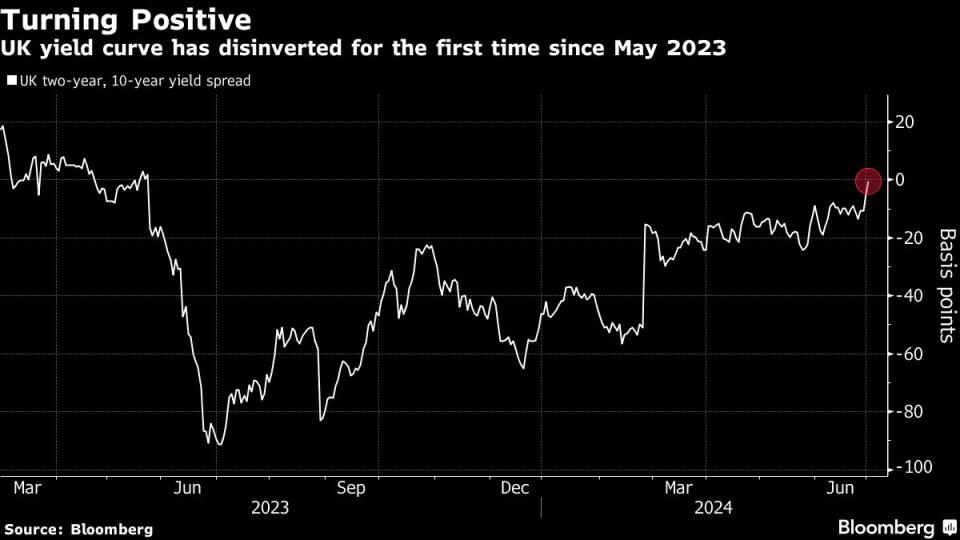Popular Bond Market Reading on UK Economy Flips Back to Normal

(Bloomberg) -- An anomaly that has plagued the UK bond market for more than a year ended on Monday, with the 10-year yield rising back above the two-year.
Most Read from Bloomberg
24-Hour Stock Trading Is Booming – and Wall Street Is Rattled
Trump as President or Private Citizen: Why Supreme Court’s Immunity Ruling Is a Test
BlackRock Deal to Make Preqin’s Founder Richer Than Larry Fink
The move restores what is considered to be a normal state of affairs, and shows investors are pricing an end to the era of tight monetary policy that had distorted rate markets, and raised concerns over the outlook for growth.
Typically, bond investors demand a higher return — or yield — for the greater uncertainty that comes with locking away their money for longer periods. But as short-term interest rates shot up across the world, that relationship broke down in major markets.
Now, with the Bank of England poised to start easing policy as early as August, the UK bond curve is starting to look normal again. It’s flat for the first time since May 2023 and strategists at UBS Group AG expect it will continue to steepen.
“We expect the BOE to cut in August, thus this should offer some steepening support,” said Emmanouil Karimalis, a strategist at UBS Group AG. “Progress in UK inflation, the labor market, and monetary policy stance are the primary drivers.”
An inverted curve has historically signaled a recession and preceded deep interest-rate cuts. But unlike previous easing cycles, the BOE is not responding to a deep economic slump this time. Rather, officials are looking to reduce rates from a 16-year high as inflation eases back to their 2% target.
Markets expect the first cut to come as early as August, with traders pricing almost one more quarter-point reduction by the end of the year.
Predictive Power
The bond moves come just days before the nation heads to the polls on Thursday, with Labour widely expected to score a resounding victory. It is also likely to revive a debate over the ability of the yield curve to predict a recession, both in the UK and elsewhere.
While the UK economy did enter a technical recession — defined as two consecutive quarters of falling gross domestic product — at the end of last year, the economic contraction was shallow and the economy has quickly rebounded.
What an Inverted Yield Curve Means for Recession Odds: QuickTake
The latest leg of the steepening is part of a global repricing led by US Treasuries. The curve there is still inverted but is slowly reverting to normal on speculation a potential Donald Trump presidency will push for tax cuts and stoke global growth.
In the UK, the yield curve is also greatly impacted by demand for longer-maturity securities by pension funds. That’s been waning as higher yields have improved the funding status of defined-benefit plans.
(Updates with context throuhgout, analyst comment.)
Most Read from Bloomberg Businessweek
The Fried Chicken Sandwich Wars Are More Cutthroat Than Ever Before
Japan’s Tiny Kei-Trucks Have a Cult Following in the US, and Some States Are Pushing Back
RTO Mandates Are Killing the Euphoric Work-Life Balance Some Moms Found
The FBI’s Star Cooperator May Have Been Running New Scams All Along
©2024 Bloomberg L.P.

 Yahoo Finance
Yahoo Finance 